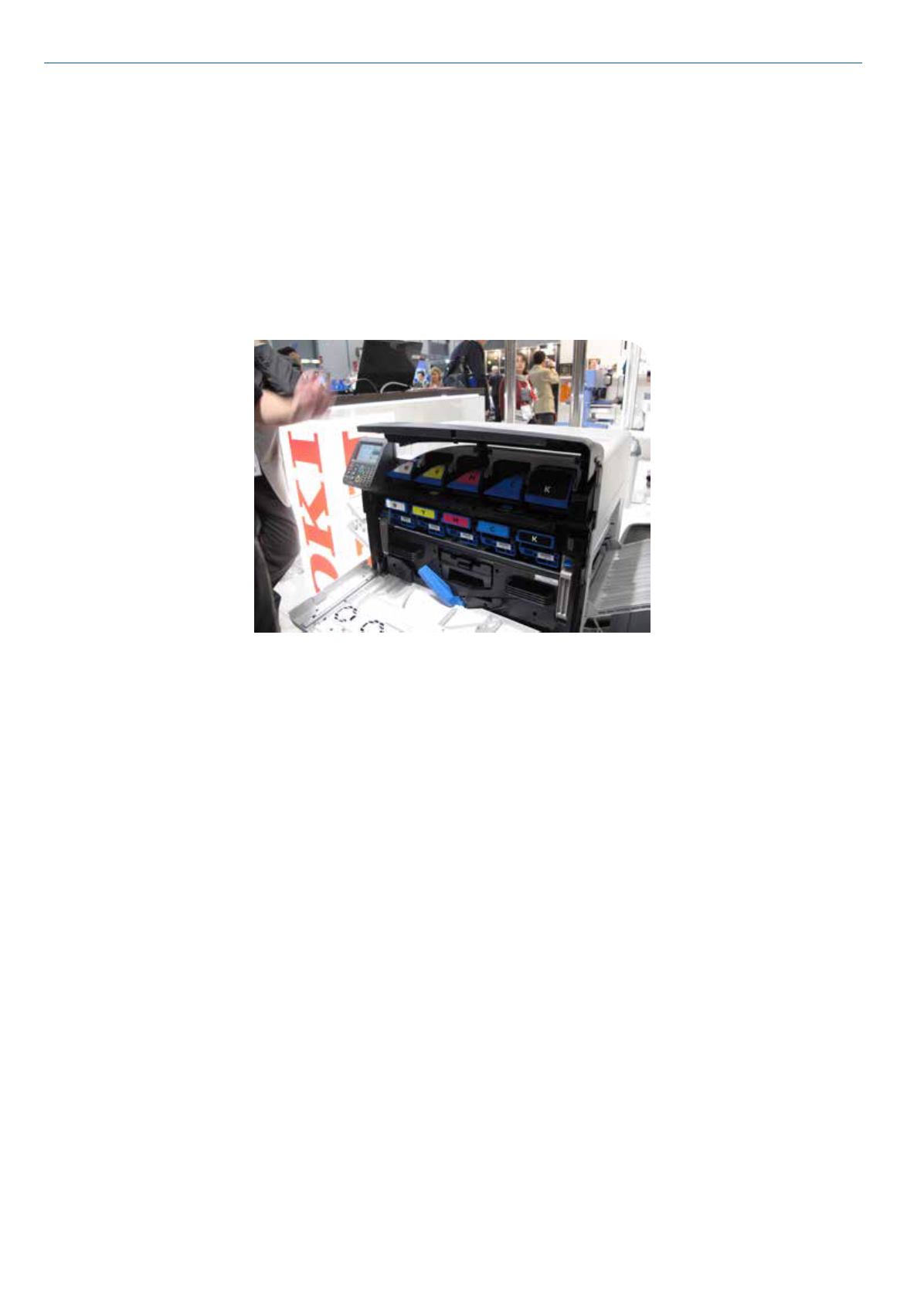
PRINT.IT
19
Innovation &
diversification
In April 2012, Takao
Hiramoto, chief executive
officer of Oki Data
Corporation, announced a
daunting three-year plan to
double sales of Oki print and
imaging solutions. At a time
of falling printer sales and
weak demand, this target
sounded highly ambitious.
Last November, on the eve of
VISCOM, Europe’s largest event
for the design, print and graphic
arts industries, Mr Hiramoto
declared that Oki remains on
track to achieve its target, having
recorded sales growth of 17% in
Financial Year 2012, with growth
of 27% in Europe, the Middle
East and Africa.
This level of growth, while
the overall market declined
by 5%, can be attributed to a
number of factors, including
changes in exchange rates and
Oki’s endeavours to improve its
production and supply base, re-
organise local sales operations
and strengthen relationships with
channel partners.
Above all, Mr Hiramoto claims
that the progress Oki has made
is testament to the company’s
commitment to innovation. He
said: “Oki’s past success and
future vision is based on growth
through diversification. This is
only possible through innovation.
What makes Oki stand out in the
printer market is its commitment
to innovation. Our success in
developing LED technology is a
great example of this.”
Innovation in the office
For users of office printers, LED
technology has a number of
advantages over conventional
laser printers, including a
smaller engine size, lower energy
consumption, reliable operation
and greater media flexibility.
These are all qualities
possessed by new Oki products
for small and medium-sized
businesses and enterprise
workgroups, from the world’s
smallest A3 colour printer, the
C800, to the MB700/MC700
series of mono/colour A4
MFPs featuring an Open API-
based software platform that
enables customers to interact
with business solutions via
the devices’ programmable
touchscreen displays.
Oki UK marketing director
Graham Lowes told
PrintIT
that these new products have
helped Oki to increase sales
across the board, in part by
offering customers a more cost-
effective alternative to existing
solutions.
“We are seeing good growth
in MFPs, both mono and
colour, especially the MB700
and MC700 high specification
machines where people would
traditionally have bought A3
copiers because that is all that
was available. They now have the
alternative of an A4 device that
not only has a small footprint but
also a lower price,” he said.
Graphics arts focus
More economical printing is also
a key selling point of new Oki
devices for graphics specialists
and commercial print providers.
Oki started the ball rolling
in 2012 with the launch of the
C711WT (A4) and C920WT (A3)
white toner printers. Instead of
cyan, magenta, yellow and black
process colours, these printers
use cyan, magenta, yellow and
white. The first printers in their
category (34/31ppm) to utilise
white toner, they make it more
economical to print short-runs of
transfers and films for everything
from T-shirts and mugs to backlit
signage and window stickers.
At the end of 2013, Oki
expanded its graphics offering
with the launch of the C931
A3 colour printer. This highly
productive device combines
high definition 1200 x 1200
dpi print quality; print speeds
of 50 pages per minute; a
consumables capacity of 38,000
pages for high volume printing
applications; and the ability to
handle a wide range of media
Specialist Printing
Oki is on target to meet aggressive growth plans as it diversifies into
new areas of the printer market. James Goulding reports
including gloss paper, film,
transfer paper and waterproof
paper in sizes up to SRA3 and
360gsm in weight.
This was quickly followed by
the Oki ES9541, the industry’s
first five toner device. The
addition of a fifth toner station,
in addition to CMYK, enables
users to enhance documents,
brochures and packaging with
spot colour in white or clear
toner (clear toner requires a
second paper pass, reducing
print speed from 50ppm to
18ppm). Alternatively, you could
print a layer of white toner in one
pass and overlay it with colour
toner in a second.
“In window film applications,
when you print a colour onto clear
film and you put it onto a window,
it looks a bit wishy-washy. But if
you lay white down first and then
lay the colours on top, suddenly
the whole thing becomes vibrant
and comes to life and you really
get strong colours and depth,”
explained Lowes.
Short runs
Whatever it is used for, Oki’s
five toner printer – like its white
toner devices – dramatically
reduces the cost of short print-
runs compared to established
solutions, opening up new
opportunities for the in-house
production of signage, packaging
and creative marketing material.
Nor, as Lowes explains, does
it just have applications in
commercial print environments.
“We see company marketing
departments as a key target for
our product – where people want
to produce in-house creatives
and short-run promotional
packaging material, like winebox
sleeves. With the clear toner you
get a very professional finish.
It’s great for in-house marketing
departments,” he said.
Oki is already developing new
toner that will expand potential
applications for the ES9541,
including metallics, such as
silver and gold, and a UV option
that would be invisible to the eye
but show up under a reading
device. It is also planning to
scale up its LED technology and
launch larger A1 and A0 devices.
Clearly, there is much more
innovation and diversification to
come.
Five is better than four: the ES9541 has already won a
PrintIT
Editor’s Choice award, a 2013 Good Design Award in Japan and a
VISCOM Best of 2013 Award in the Textile Finishing category.


